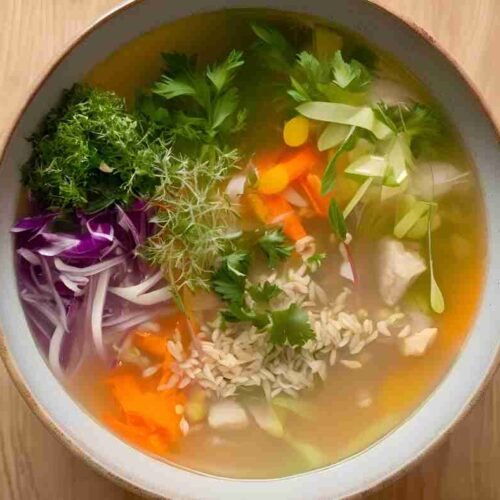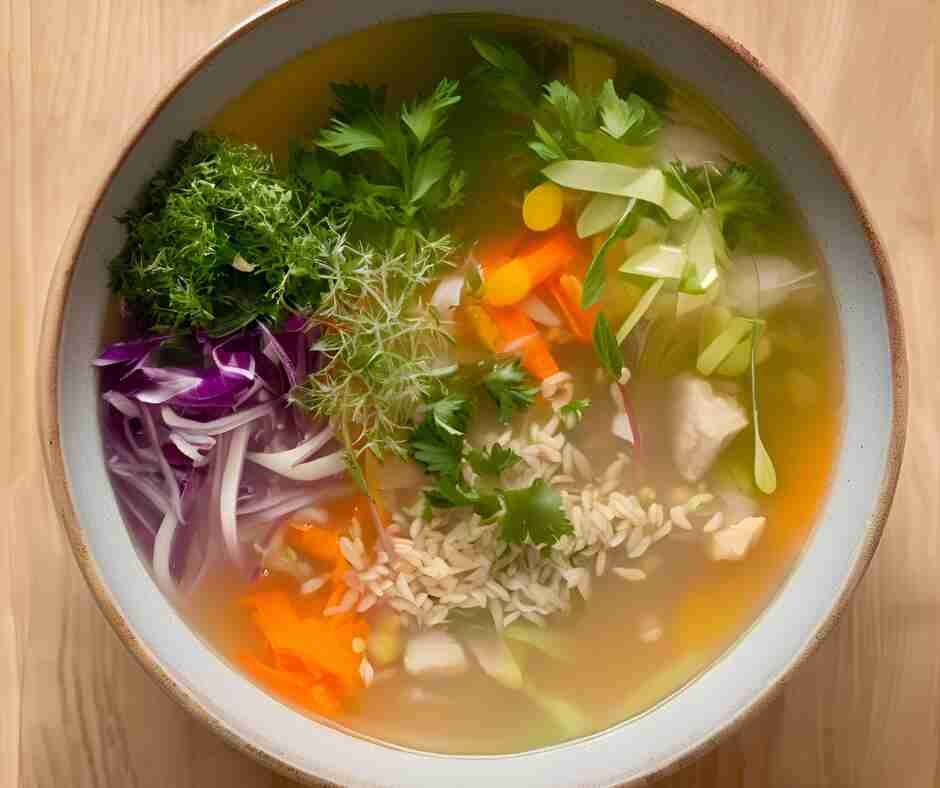Have you ever considered what makes a soup “clear”? Maybe you know about clear soup but aren’t sure exactly what it means. You are going to have a treat, then. From its definition and background to how you could create your own mouthwatering bowl right at home, this thorough guide will take you through the realm of transparent soups.
A. Definition of clear soup
As the name implies, clear soup is a translucent liquid-based dish with mild taste usually produced from a well-strained broth or stock. Clear soups stand out from chunky or cream-based soups in that they taste cleanly and clearly. Small, delicate bits of vegetables, meats, or herbs that accentuate the soup without detracting from its look abound on garnishes for them.
B. Brief history and cultural significance
For millennia, culinary customs all over have included clear soups. They first became well-known in Western cuisine as a sophisticated dish in French high cuisine in the 17th and 18th century. Clear soups have been mainstay in Asian cultures, especially in Chinese and Japanese cuisine, for even longer; they are usually first or palette cleanser.
II. Types of Clear Soups
Clear soups appear in many varieties, each with distinctive qualities and cooking techniques. Let’s discuss some of the most often occurring varieties:
A. Consommé
Perhaps the height of transparent soups is consommé. Rich in taste yet absolutely transparent in appearance, this is a very cleared broth. Made historically from beef or chicken stock, consommé is specially clarified using egg whites to eliminate toxins.
B. Bouillon
Made from several components including vegetables, poultry, or beef, bouillon is a basic, light broth. Though less polished than consommé, it still tastes great.
C. Broth
Made by cooking meat, vegetables, or both in water, broth is a basic transparent soup. It’s flexible and the foundation for many different soups and dishs.
D. Asian-style clear soups
Clear soups abound in Asian cuisines: Thai tom yum soup, Chinese egg drop soup, or Japanese miso soup (when prepared with a clear dashi base). Many times, these soups have distinctive tastes and ingredients typical of their particular cuisines.
III. Health Benefits of Clear Soup
Clear soups are not only great but also rather healthful. Let’s consider some reasons you may want to include more clear soups into your diet:
A. Low in calories
Those trying to monitor their weight or searching for a light dinner can definitely choose clear soups as they are inherently low in calories.
B. Hydration
Clear soups’ great water content helps you stay hydrated, which is vital for general health and body processes.
C. Digestive aid
Clear soups’ readily digested, warm liquid components may be comforting for the digestive tract, which is why you should always have them on hand when you’re feeling under the weather.
D. Nutrient-rich
Clear soups, despite their low weight, may be bursting with nutrients from the meats, herbs, and vegetables used in their making. They are a great source of readily absorbed variation of minerals and vitamins.
IV. Key Ingredients in Clear Soup
Though its simplicity makes transparent soup beautiful, this does not imply it lacks taste or complexity. These are the main ingredients of a great clear soup:
A. Base ingredients
1. Water or stock
Any transparent soup starts with its liquid basis. Though most usually it’s a tasty stock produced from bones, vegetables, or both, this may be just water.
2. Aromatics (onions, garlic, ginger)
These components provide the soup richness and depth, hence forming its taste basis.
B. Vegetables
Clear soups receive taste and nourishment from vegetables. Though the selections are unlimited, common ones include leeks, celery, and carrots.
C. Proteins
Though not usually present, proteins such as chicken, beef, or tofu provide soups body and nourishment.
D. Herbs and spices
Fresh herbs and well selected spices give layers of taste without clouding the broth, therefore improving the flavor character of a clear soup.
V. How to Make Clear Soup: Step-by-Step Guide
All set to give creating clear soup some of your try? Use these guidelines for a great handmade variation:
A. Choosing your base
First decide on your soup foundation. Will you create from scratch a stock or use water? Made from scratch stock is the best for most delicious outcomes.
B. Preparing ingredients
Cut your meats and veggies into uniformly tiny pieces. This guarantees homogeneous cooking and facilitates consumption.
C. Cooking process
- Start in a big saucepan sautéing your aromatics.
- Bring your preferred stock or water to a simmer.
- Add proteins and veggies, cooking until soft.
- Taste-test and season with herbs and spices.
D. Straining and clarifying
Strain the liquid through a fine-mesh sieve or cheese cloth for the clearest soup. The egg white technique used in producing consommé will help to provide even more clarity.
VI. Variations of Clear Soup Recipes
Clear soups have a wide range and universe. Here are some well-known variants you might like to try:
A. Vegetable clear soup
Excellent for vegetarians or as a first dish, this is a light and reviving choice.
B. Chicken clear soup
Often connected with combating colds and flu, this is a typical comfort.
C. Beef clear soup
Rich and delicious, beef clear soup is substantial without weight.
D. Seafood clear soup
Popular in coastal cuisine all around, delicate and savory seafood clear soups include
VII. Serving and Presentation
Presentation of transparent soup is just as crucial as its cooking technique. These suggestions help your soup to shine:
A. Garnishing ideas
Extra taste and visual appeal might come from fresh herbs, finely sliced vegetables, or a drizzle of good-quality oil.
B. Accompaniments
For a whole dinner, think about presenting your transparent soup with crusty bread, crackers, or a side salad.
C. Temperature considerations
Though certain versions, like consommé, may be eaten cold, particularly in summer, clear soups are usually served hot.
VIII. Clear Soup in Different Cuisines
Every cuisine has clear soups with its own special twist:
A. Japanese clear soups
Clear soups abound in Japanese cuisine; among them are the delicate suimono and the more sturdy sumahi jiru.
B. Chinese clear soups
Chinese clear soups, prized for their health advantages as much as their flavor, typically include medicinal herbs.
C. Western clear soups
Clear soups like consommé are often connected in Western cuisine with elegant palates and excellent dining.
IX. Tips for Perfect Clear Soup
Consider these ideas to guarantee that your clear soup a success every time:
A. Ingredient selection
For optimal taste and nutritional worth, choose the freshest ingredients you can find.
B. Cooking techniques
To maintain the soup clear and avoid cloudiness, simmer instead of boiling.
C. Common mistakes to avoid
A great clear soup might be compromised by overcooking vegetables, underseasoning, or excessive use of oil.
X. Clear Soup vs. Other Soup Types
In what ways does clear soup fare versus other soups?
A. Comparison with cream-based soups
Clear soups are light and reviving, whereas cream soups are rich and filling; hence, they fit diverse tastes and times.
B. Differences from chunky soups
While clear soups are usually lighter and often used as a starter or side dish, chunky soups are more satisfying and usually eaten on their own.
XI. Storing and Reheating Clear Soup
Maintaining the quality of your clear soup depends mostly on proper storage and reheating:
A. Proper storage methods
Clear soup keeps best in an airtight container in the refrigerator for three to four days.
B. Reheating techniques
On the burner, reheat gradually to avoid boiling and help to keep the soup from cloudiness.
XII. Clear Soup in Special Diets
One may adjust clear soups to suit different dietary requirements:
A. Clear soup in weight loss diets
Often advised in weight reduction diets are low in calories yet full soups with clear consistency.
B. Clear soup for convalescence
Clear soups’ simple digestibility makes them perfect for those recuperating from sickness.
C. Vegan and vegetarian clear soups
Clear soups may be readily vegan or vegetarian-friendly by substituting vegetable stock and plant-based proteins.
XIII. Frequently Asked Questions
A. Can I freeze clear soup?
Indeed, transparent soups freeze really well. Stow in sealed containers for up to three months.
B. How long does clear soup last in the refrigerator?
Clear soup kept right can last three to four days in the refrigerator.
C. Can I add noodles to clear soup?
Undoubtedly! Many clear soup s, particularly from Asian cuisines, call for noodles. To avoid them from being soggy, simply make sure to boil them separately and toss them soon before serving.
XIV. Conclusion
Clear soups are evidence of the beauty in cooking’s simplicity. They provide something for everyone with their clean tastes, health advantages, and adaptability. Clear soup is a great light appetizer, a warming bowl on a chilly day, or a mild dinner after recuperation. So why not try your hand at creating a pot of pure soup? Your body—and your taste receptors—will reward you!
Clear Vegetable Soup Recipe

Ingredients
- 8 cups vegetable broth
- 1 medium onion finely chopped
- 2 cloves garlic minced
- 2 medium carrots diced
- 2 celery stalks diced
- 1 small zucchini diced
- 1 cup green beans cut into 1-inch pieces
- 1 cup cabbage shredded
- 1 tablespoon olive oil
- 1 bay leaf
- 1 teaspoon dried thyme
- Salt and pepper to taste
- 2 tablespoons fresh parsley chopped
Instructions
- Heat olive oil in a large pot over medium heat. Add onions and garlic, sauté until translucent, about 3-4 minutes.
- Add carrots and celery, cook for another 3-4 minutes.
- Pour in the vegetable broth and add the bay leaf and thyme. Bring to a boil, then reduce heat and simmer for 10 minutes.
- Add zucchini, green beans, and cabbage. Simmer for another 10-15 minutes or until all vegetables are tender.
- Season with salt and pepper to taste.
- Remove the bay leaf before serving.
- Garnish with fresh parsley and serve hot.
Notes
- Calories: 120
- Total Fat: 3.5g
- Saturated Fat: 0.5g
- Cholesterol: 0mg
- Sodium: 580mg
- Total Carbohydrates: 20g
- Dietary Fiber: 5g
- Sugars: 8g
- Protein: 4g
- Vitamin A: 120% DV
- Vitamin C: 45% DV
- Calcium: 6% DV
- Iron: 10% DV
